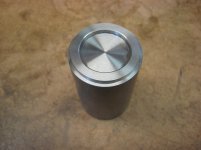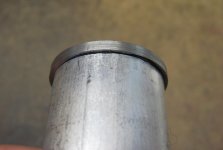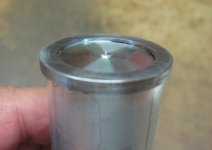gbyoung
Cast Iron
- Joined
- Feb 2, 2011
- Location
- Richmond, VA
After following a thread on a M/C forum about a local fella’s need for a countershaft sprocket spacer, I did one in the background just to see if I could. Most/all of what I’ve been playing with is aluminum, so turning this out of steel presented new challenges for me and was a good learning experience.
I turned one that was ~2.5mm thick out of a 1.5” dia., 1215 steel rod that was 35mm OD and 25mm ID. After playing with spindle speed (slow via the back gear), I think we got it figured out and it turned out pretty decent.
While the full length of the rod was chucked up, it was easy to clean up the spacer’s face, and bevel the inside and outside edges (what you see in the pix). But, how do you do that once you’ve parted the spacer from its host piece of stock?
I can see how you could chamfer the outside edge before you completely part the piece free, but how do you clean up the face of the parted side and chamfer the inside edge of that side’s hole? Trying to get something that thin chucked back up straight is a PITA.
So, how do you professionals do it?

I turned one that was ~2.5mm thick out of a 1.5” dia., 1215 steel rod that was 35mm OD and 25mm ID. After playing with spindle speed (slow via the back gear), I think we got it figured out and it turned out pretty decent.
While the full length of the rod was chucked up, it was easy to clean up the spacer’s face, and bevel the inside and outside edges (what you see in the pix). But, how do you do that once you’ve parted the spacer from its host piece of stock?
I can see how you could chamfer the outside edge before you completely part the piece free, but how do you clean up the face of the parted side and chamfer the inside edge of that side’s hole? Trying to get something that thin chucked back up straight is a PITA.
So, how do you professionals do it?








